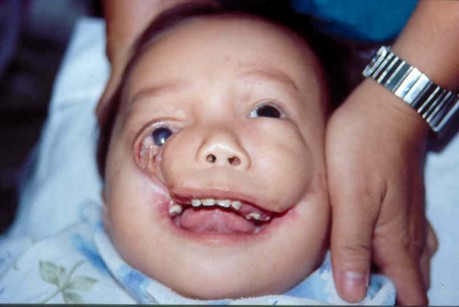Classification of facial clefts and fissures that take the orbital cavity as anatomical starting point. It is unrelated to the embryology or the cause of the defect, which could be genetic, ischemic or an amniotic band in some cases. There are 15 numbered clefts from 0 to 14 and 30 (figure)
Some slots are the cause of defects:
- 0 and 14: hypertelorism
- 3 (orbitomaxillary) internal: microphthalmia, abnormalities of the nasolacrimal tract
- 4 (orbitomaxillary) median: defect of the floor of the orbit and the orbital rim
- 5 (orbitomaxillary) external: microphthalmia and abnormalities of the middle third of the lower eyelid
- 6 (intermaxillo-zygomatic), , 7, 8 : Treacher-Collins syndrome
- 7 (temporo-zygomatic): hemifacial microsomia
- 8 (fronto-zygomatic): Goldenhar syndrome
- 9 (orbital injection): microphthalmia, abnormalities of the superoexternal angle of the orbit
- 10: iris and upper eyelid coloboma, ablepharia
- 11: hypertelorism, coloboma of the inner third of the palpebra
.jpg)
on the left: bone clefts; on the right: soft tissue clefts.
Different identified clefts:
♦ cranial clefts, present at and above the orbital roof, numbered 8 to 14.
♦ facial clefts, present at and below the orbital floor, numbered 0 to 7, plus cleft 30.
There are also orofacial clefts involving the oral cavity and comprising :
♦ atypical orofacial clefts (some median or oblique clefts: Tessier 0, 30, 3, 4, 5, 7),
♦ typical orofacial clefts (paramedian clefts of the lip and/or palate: Tessier 1 and 2).
A cardiac malformation is present in some cases: VSD, ASD, double outlet right ventricle, tetralogy of Fallot.
Anesthetic implications:
echocardiography; risk of difficult intubation but especially difficulties with facial mask ventilation: it may be useful to fill bone defects with wet compresses or a transparent occlusive dressing, or to use some malleable material (e.g., as for dental impressions). Eye protection against pressure and corneal erosions; laryngeal mask successfully used to ventilate and provide guidance for intubation with a fiberscope

References:
- Komatsu H, Matsumoto S, Mitsuhata H, Abe K.
Airway management in an infant with Tessier type 3 cleft.
Anesthesiology 199; 90: 1800.
- Carenzi B, Corso RM, Stellino V, Carlino GD, Tonini C, Rossini L, Gentili G.
Airway management in an infant with congenital centrofacial dysgenesia.
Br J Anaesth 2001; 87: 726-8.
- Kumar K, Ninan S, Saravanan PA, Prakash KS, Jeslin L.
Airway management in an infant with Tessier n 4 anomaly.
J Anaesthesiol Clin Pharmacol 2011; 27: 239-40.
- Tessier P.
Anatomical classification of facial, craniofacial and laterofacial clefts.
J Maxillofac Surg 1976; 4: 69-92.
- George B, Lagoo J, Narendra SM, Goerge J.
Anaesthetic management of a child with a rare congenital malformation: bilateral macrostomia as an isolated asyndromic entity.
Ind J Anaesth 2014; 58: 489-50.
- Ramachandran R, Rewari V, Kumar A.
Difficult airway management in an infant with bilateral Tessier number 4 cleft.
Acta Anesthesiol Belg 2014;65:77-80.
- Veerabathula P, Patil M, Upputuri O, Durga P.
Simple solution for difficult face mask ventilation in children with orofacial clefts.
Pediatr Anesth 2014; 24: 1106-8.
- Eichhorn MG, Iacobucci JJ, Turfe Z.
An unusual craniofacial cleft : amniotic band syndrome as a possible cause.
Int J Pediatr Otorhinolar 2015 ; 79 : 616-9
- Fandino A, Herrera AJ, Feo OE, Ronderos AM, Ospina JC, De Leon O.
Congenital meningocele associated with corpus callosum agenesis and midline superior labial cleft due to Tessier 0-14 facial fissure : a case report.
Int J Pediatr Otorhinolaryngol 2020; 130: 2020; 129 doi/10.1016/j.ijporl.2019.109764
- Benhammou A, Jazouli N, Kzadri M, Benhammou M.
Fente glosso-labio-mandibulo-sternale.
Revue de Stomatologie et de Chirurgie maxillo-faciale 2008 ; 107 :41-3.
- Nazari S, Vaezi A, Mossavarali, Ghanavati K, Akbar Shafiee.
Cardiovascular anomalies in patients with Tessier syndrome: a systematic review.
Eur J Pediatr 2024 ; 183:73–82
Updated: February 2024